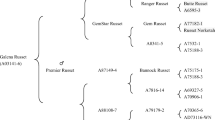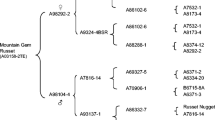Abstract
La Belle Russet is an early-maturing, medium-russeted, potato variety, with attractive tubers across environments, suitable for both fresh-pack and processing. In early-harvest trials, La Belle Russet had total and marketable yields comparable to Russet Norkotah. However, unlike Russet Norkotah, La Belle Russet can be processed into French fries following up to 7 months storage at 8.9 C and has a low incidence of sugar ends. La Belle Russet is unusual for an early-maturing variety, in having a long tuber dormancy that is comparable to that of Russet Burbank; a variety which is recognized for having the longest tuber dormancy among North American potato varieties. In full-season trials, total yield of the earlier-maturing La Belle Russet tended to be lower than Ranger Russet and Russet Burbank, however marketable yield was comparable to these industry standards due to a significantly higher percentage of U.S. No. 1 tubers—reflecting its low incidence of tubers having growth cracks and second growth. La Belle Russet has shown significantly lower levels of the amino acid asparagine relative to Ranger Russet and Russet Burbank, which may contribute to lower acrylamide levels in French fries and other processed potato products. La Belle Russet has moderate resistance to common scab (Streptomyces spp.) and Fusarium dry rot (F. solani var. coeruleum). La Belle Russet was released in 2019 by the USDA-ARS and the Agricultural Experiment Stations of Idaho, Oregon, and Washington, and is a product of the Pacific Northwest Potato Variety (Tri-State) Development Program.
Resumen
La Belle Russet es una variedad de papa de maduración temprana, medianamente tipo russet, con tubérculos atractivos en todos los ambientes, adecuados tanto para el envasado fresco como para el procesamiento. En ensayos para cosecha temprana, La Belle Russet tuvo rendimientos totales y comercializables comparables a Russet Norkotah. Sin embargo, a diferencia de Russet Norkotah, La Belle Russet se puede procesar en papas fritas después de hasta 7 meses de almacenamiento a 8.9 °C y tiene una baja incidencia de extremos de azúcar. La Belle Russet es inusual para una variedad de maduración temprana, ya que tiene una dormancia larga de tubérculos que es comparable a la de Russet Burbank; una variedad que es reconocida por tener la latencia de tubérculos más larga entre las variedades de papa de América del Norte. En los ensayos de ciclo de cultivo completo, el rendimiento total de La Belle Russet de maduración temprana tendió a ser más bajo que Ranger Russet y Russet Burbank, sin embargo, el rendimiento comercializable fue comparable a estos estándares de la industria debido a un porcentaje significativamente mayor de tubérculos No. 1 de los Estados Unidos, lo que refleja su baja incidencia de tubérculos que tienen grietas de crecimiento y crecimiento secundario. La Belle Russet ha mostrado niveles significativamente más bajos del aminoácido asparagina en relación con Ranger Russet y Russet Burbank, lo que puede contribuir a niveles más bajos de acrilamida en papas fritas y otros productos de papa procesados. La Belle Russet tiene una resistencia moderada a la costra común (Streptomyces spp.) y a la pudrición seca de Fusarium (F. solani var. coeruleum). La Belle Russet fue liberada en 2019 por el USDA-ARS y las Estaciones Experimentales Agrícolas de Idaho, Oregon y Washington, y es un producto del Programa de Desarrollo de variedades de papa noroccidental del Pacífico (Tri-State).




Similar content being viewed by others
References
Bali, S., V. Sathuvalli, C. Brown, R. Novy, L. Ewing, J. Debons, D. Douches, J. Coombs, D. Navarre, J. Whitworth, B. Charlton, S. Yilma, C. Shock, J. Stark, M. Pavek, and N.R. Knowles. 2017. Genetic fingerprinting of potato varieties from the northwest potato variety development program. American Journal of Potato Research 94: 54–63.
Bergers, W.W. 1980. A rapid quantitative assay for solanidine glycoalkaloids in potatoes and industrial potato protein. Potato Research 23: 105–110.
Bradford, N.M. 1976. A rapid and sensitive method for the quantitation of microgram quantities of protein using the principle of protein dye binding. Analytical Biochemistry 72: 248–254.
Brown, C.R., H. Mojtahedi, G.S. Santo, P. Hamm, J.J. Pavek, D. Corsini, S. Love, J.M. Crosslin, and P.E. Thomas. 2000. Potato germplasm resistant to corky ringspot disease. American Journal of Potato Research 77: 23–27.
Brown, C.R., H. Mojtahedi, J.M. Crosslin, S. James, B. Charlton, R.G. Novy, S.L. Love, M.I. Vales, and P. Hamm. 2009. Characterization of resistance to Corky ringspot disease in potato: A case for resistance to infection by tobacco rattle virus. American Journal of Potato Research 86: 49–55.
Corsini, D., and J.J. Pavek. 1986. Fusarium dry–rot resistant potato germplasm. American Potato Journal 63: 629–638.
Corsini, D.L., J.J. Pavek, and J.R. Davis. 1988. Verticillium wilt resistance in non-cultivated tuber-bearing Solanum species. Plant Disease 75: 148–151.
Corsini, D.L., J.J. Pavek, M.W. Martin, and C.R. Brown. 1994. Potato germplasm with combined resistance to leafroll virus and viruses X and Y. American Potato Journal 71: 377–385.
Ellis, G.D., L.O. Knowles, and N.R. Knowles. 2020. Developmental and postharvest physiological phenotypes of engineered potatoes (Solanum tuberosum L.) grown in the Columbia Basin. Field Crops Research 250: 107775. https://doi.org/10.1016/j.fcr.2020.107775.
Johansen, R.H., B. Farnsworth, D.C. Nelson, G.A. Secor, N. Gudmestad, and P.H. Orr. 1988. Russet Norkotah: A new russet-skinned potato cultivar with wide adaptation. American Potato Journal 65: 597–604.
Love, S.L., R.G. Novy, J.L. Whitworth, D.L. Corsini, J.J. Pavek, A.R. Mosley, M.J. Pavek, N.R. Knowles, C.R. Brown, S.R. James, and D.C. Hane. 2006. Western russet: A new potato variety with excellent fresh market and frozen-fried processing quality and field resistance to common scab and PVY0. American Journal of Potato Research 83: 161–169.
Mosley, A., S. Yilma, D. Hane, S. James, K. Rykbost, C. Shock, B. Charlton, E. Eldredge, and L. Leroux. 2003. Oregon. In National Potato Germplasm Evaluation and Enhancement Report, ed. K.G. Haynes, vol. 2001, 369–388.
Pavek, J.J., D.L. Corsini, S.L. Love, D.C. Hane, D.G. Holm, W.M. Iritani, S.R. James, M.W. Martin, A.R. Mosley, J.C. Ojala, C.E. Stanger, and R.E. Thornton. 1991. Frontier russet: A new potato variety for early fresh and processing use with resistance to fusarium dry rot. American Potato Journal 68: 525–532.
Pavek, M.J., Z.J. Holden, R.R. Spear, and B.J. Weddell. 2018. Improving land use efficiency and grower revenue by reducing potato row width. American Journal of Potato Research 95: 451–462.
Ross, F.A. 1959. Dinitrophenol method for reducing sugars. In Potato processing, ed. W.F. Talburt and O. Smith, 469–470. Westport: AVI Publ.
Spear, R.R., Z.J. Holden, and M.J. Pavek. 2017. Fresh market evaluation of six russet-type potato varieties and four russet Norkotah strains. American Journal of Potato Research 94: 437–448.
United States Department of Agriculture-Agricultural Marketing Service. 2011. United States Standards for Grades of Potatoes. p 2.
Webb, R.E., D.R. Wilson, J.A. Frank, J.R. Shumaker, B. Graves, and M.R. Henninger. 1981. BelRus: A new russet skin potato variety, combining high quality, pest resistance, and adaptation to the northeastern United States and Florida. American Potato Journal 58: 111–116.
Acknowledgements
The authors thank Moises Aguilar, Margaret Bain, Nichole Baley, Todd Carter, Jeanne Debons, Lorie Ewing, Jenny Durrin, Mary Jo Frazier, Nora Fuller, Rudy Garza, Darren Hall, Mark Fristad, Zach Holden, Chelsey Lowder, Lura Schroeder, Steve Wheeler (deceased), and Lynn Woodell for their contributions to the development and release of La Belle Russet, as well our collaborators in the Western Regional Potato Variety Trials, the National Fry Processing Trial, and the Idaho, Washington, and Oregon potato commissions. We also thank our industry cooperators for their substantial contribution to this research effort, most notably Ginette Cardinal, Pommes de terre Laurentiennes, Inc., Notre-Dame-de-la-Paix, Quebec, Canada for her field evaluations and early identification of the merit of La Belle Russet, and her subsequent efforts in the development of industry interest in La Belle Russet. Development of La Belle Russet was partially funded by USDA/NIFA (Potato Breeding Research SCRI Grant #2019-34141-30291), the Northwest Potato Research Consortium, and by contributions from the potato processing industry to the National Fry Processing Trial.
Author information
Authors and Affiliations
Corresponding author
Ethics declarations
Conflict of Interest
The authors have no competing interests to declare that are relevant to the content of this article that could be construed as a potential conflict of interest.
Additional information
J. C. Stark, N. R. Knowles, L. O. Knowles are Retired
C. R. Brown is Deceased
Rights and permissions
About this article
Cite this article
Novy, R.G., Whitworth, J.L., Stark, J.C. et al. La Belle Russet: an Early Maturing, Dual-Purpose Variety Having a High Percentage of Marketable Yield, Long Tuber Dormancy, and a Reduced Incidence of Sugar Ends. Am. J. Potato Res. 98, 395–410 (2021). https://doi.org/10.1007/s12230-021-09853-0
Accepted:
Published:
Issue Date:
DOI: https://doi.org/10.1007/s12230-021-09853-0




